During at least three months after the nationwide protests started with the death of Mahsa Amini in the custody of morality police, international media outlets published pictures of women who cut off their hair and threw it to the ground or hanged their headscarves on sticks and burned them as a symbol of subjugation and misogyny. From the very first day, protest theater was ingrained in what has become known as the Mahsa Uprising.
On November 25, 2022, one could hear disturbing sounds like a funeral march or drumbeats of warning coming from the front of the Netherland’s Foreign Ministry. More than 20 members of the theatrical company Tales of A Revolution stood on white stands in the front of the ministry’s building, with a blood drop painted on their faces. They played a march with bottles of mineral water and shouted “Shut down the Iranian embassy”, “Your silence is violence” and “Woman, Life, Freedom.” Also standing in front of the Foreign Ministry with an emaciated face and holding a petition scroll was Baluch activist Masoud Hamidi-Far, who for two weeks had staged a sit-in there in the harsh winter of the Netherlands.
This powerful performance heightened the interest of the Dutch public, media outlets and eventually politicians in the events happening in Iran.
On December 14, 2022, while voting for expelling the Islamic Republic from the UN Commission on the Status of Women was in progress, the US-based Iranian sculptor Ramin Etemadi Bozorg stood in the freezing cold of New York from 9:50 to 11:33, holding a big piece of red-colored ice, sculpted in the shape of Iran. The ice melted little by little into a small stream in the color of blood.
With this powerful performance, he told the spectators that the distressful situation in Iran needs urgent attention and every moment of procrastination by politicians would cost the lives of tens of Iranians.
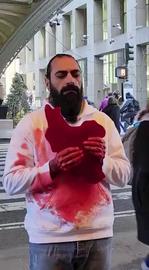
Some of these performances are rooted in the most ancient rites of Iranian culture, in which cutting hair has been a ceremonial rite of Iranian women to mourn and protest. This rite has found its way into Iranian mythology and poetry, such as the story of Siavash, a mythological Iranian prince and a major figure in Ferdowsi’s "Book of Kings," whose unjust and tragic death is mourned by women who cut their hair.
But the performers have also borrowed images, concepts or themes familiar to an international audience to make the situation in Iran more tangible for them. For instance, at the height of the protests, many pictures were posted online of protesting Iranian women in the streets who were dressed like characters in the TV series The Handmaid’s Tale, an adaptation of a novel by Margaret Atwood that takes place in a fictitious totalitarian and patriarchal state by the name of the Republic of Gilead.
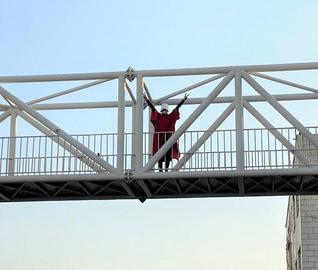
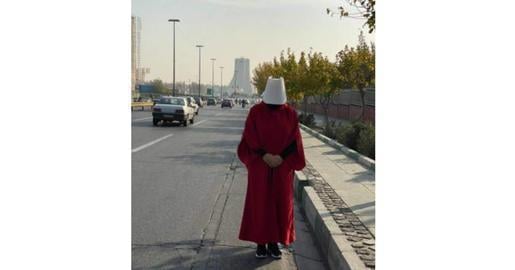
In December 2022, a group of women, dressed like the handmaids in the TV series, held a demonstration in the US city of Seattle to protest against the Islamic Republic.
On International Women’s Day on March 8, 2023, in a march organized by the group Stage of Freedom in the center of London from the Palace of Westminster to the Iranian embassy in Kensington, women who were dressed like the characters in The Handmaid’s Tale carried pictures of those killed during the protests in Iran. Some had a patch on one eye to remind people of hundreds of protesters who had been blinded by the security forces.
This march, with women in red cloaks carrying pictures with the words “Woman, Life, Freedom,” was visually so impressive that the spectators could not help wanting to know more about it.
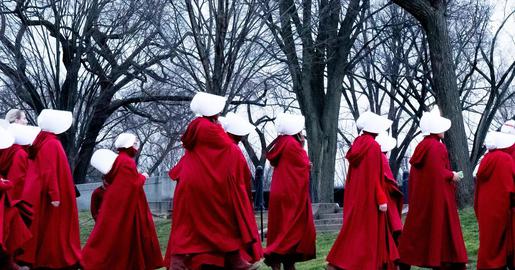
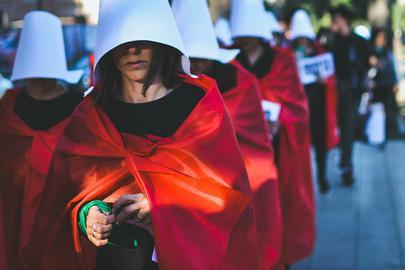
On March 7, 2023, in response to a wave of chemical attacks on girls' schools across Iran, students staged a protest theater in the courtyard of Tabriz University. Female students, wearing black blindfolds reminiscent of protesters who had been executed, sat on the ground as security forces angrily milled around them. Then one of them started chanting: “We swear to your name, a name which is our watchword, that Mahsa’s night will dawn with a hundred voices.” Then she put her hand on the shoulder of the students next to her who, in turn, raised their heads and joined the chant. The same thing was repeated when each student “woke up” the next student.
When all the girls had joined hands, they “rose up” and this time sang the song more forcefully. Then two men with covered faces approached them, moved around them for a little while and then released a “gas” into the air. The girls started coughing. A woman entered the scene and helped one of them. A man entered the scene to help as well and then a woman, clad in full-length chador, ran to the girl who had been poisoned. At this point, they all held each other’s hands and finished their song with more resonance: “Sing so that the city becomes the song of women! So that this country becomes our country!”
Some believe such modes of protests are much less important and much less effective than street demonstrations. This view is the result of a misunderstanding of both the essence of the word “demonstration” and its etymology. The Latin root of “demonstrate” means “to show” and it has come to mean “show clearly,” “manifest,” “show to be true,” “to present by experiment” and so on. The Persian word for “demonstration,” adapted from the Arabic word “tazahorat,” also signifies “to show” and “to manifest.” But etymology aside, all street demonstrations, in any shape or form, have dramatic aspects because they are meant to bring an issue to the public’s attention or at least “put on a show” through bodily gestures and behavioral patterns.
According to performance theorist and practitioner Marcela Fuentes, “performance” applies to any structured behavior in everyday life that carries with itself the politics of the embodiment of an idea: “The relationship between performance and politics informs a wide range of behaviors, subjects, and agents, spanning from individual bodies to protest bodies…Contemporary activism in both its ‘live’ and online deployments exposes the intertwined relationship between aesthetics and politics.” The arena of symbols and behaviors is the most important arena of the conflict between the government and the people.
Those who say that using these dramatic symbols and behaviors is futile have forgotten that the starting point of the most important wave of anti-government protests in Iran was a full-fledged performance. It was a revolutionary performance that lasted a few minutes in the morning of December 7, 2017, when young woman by the name of Vida Movahed stood on a telephone exchange box in Tehran’s Enghelab (“Revolution”) Street, tied her white shawl to a stick and waved it in the air in protest against forced hijab. She became known as the “Revolution Woman”, and soon other young women in several cities across Iran followed her example.
The term “performance” is well-suited to describe the acts of confrontation that we have witnessed during the recent nationwide protests. On the one hand, this word denotes “completing an act” and, on the other hand, it points to the “dramatic aspects of an action,” to how an act is carried out. But it also hints at how individuals and groups use language. Protests in Iran can be studied from all these three angles.
The Iranian “revolution women” presented us with a perfect “performance” that can only be called “guerilla theater.” They adopted the tactics and the goals of guerrilla warfare but adapted them to a peaceful way of fighting.
How Guerilla Theater Resembles Guerilla Warfare
Guerrillas launch operations to liberate part of the territory occupied by the enemy, but they disappear before the forces of the enemy arrive to annihilate them so they can fight another time and/or another place. This “territory” is not necessarily only geographical but it can be part of the people’s mind.
Therefore, we can define guerrilla theater in these general terms: implementation and adaptation of guerilla warfare tactics in performances in any public space that aim to bring about revolutionary changes in the political and social order.
The first goal is to challenge those forms of civil struggle that have lost the power to change society. In this way we attack the minds of our audience, our own minds and the inflexible laws of a political and cultural environment, and we liberate them, at least temporarily.
Guerrilla theater uses the tactic of a surprise attack and relies on local facilities and unpredictable and irregular movements to occupy the public arena and the public mind. This is why we can understand guerrilla warfare within the context of Hakim Bey’s “Temporary Autonomous Zones,” short-lived spaces which elude formal structures of control. A guerrilla “performance” takes place in an unexpected moment, takes back the control of a part of public space from the ruling authority and liberates it for a short while. Then it disappears but reappears at another unexpected time and place.
"Revolution Women" were the initiators of these temporary autonomous zones. They would temporarily occupy a telephone exchange box, a sidewalk, a street corner or a cement block and turn it into an autonomous zone where hijab was not mandatory. We can see the same thing in recent protests when actresses, athletes and well-known figures take off their hijab during official and public ceremonies.
In February Zainab Kazempour, a female member of the Construction Engineering Organization of Tehran province, flung away her headscarf during the election of its board of directors after she was barred from running because she did not wear the mandatory hijab. She first grabbed the microphone and said: “I do not recognize the assembly that doesn't allow candidates to run for not wearing a headscarf.” She then threw her headscarf at the large picture of Supreme Leader Ali Khamenei on the wall, thus taking the control of the stage away from the authorities for a few minutes.
And in November, the actress Hengameh Ghaziani was arrested after publishing a video of herself in which she appeared in a street of Tehran without headscarf. She shared the video on Instagram along with the caption: “This might be my last post. From this moment on, whatever happens to me, know that as always, I am with the Iranian people until my last breath.” Ghaziani, like the young Iranians who danced in front of the Azadi Tower in Tehran, were also taking control of the public space away from the ruling power for a short time.
The most important characteristic of these protests is that they have targeted one of the most forbidden political and religious foundations of the Iranian regime. By targeting the most sacred visual taboo in the social life of the Islamic Republic, the protesters have also challenged the absolute domination of the government in other fields as well.
The other characteristic of these protest performances, however, is what they teach Iranian society: observe and participate. With their actions, the protesters have brought up a problem — depriving individuals of the right to choose — and have offered a solution — publicly challenging the oppressive regime in the arena that it believes it owns. And they have brought up the problem and offered the solution in the form of spectacles which can quickly turn into symbols that can be replicated.
The idea of fighting with dramatic tools gives the protesters a better chance of being seen and allows their message to travel further, especially in an age dominated by media outlets that have a craving for breathtaking pictures.
Some believe that such techniques only work on the middle class or the so-called elite but they are absolutely wrong. In 2017, people and shop owners in the city of Fereidan in Isfahan province put on a perfect show in front of the city governor’s office. Hundreds of people laid empty tablecloths in front of the building and ate breadcrumbs as a dramatic gesture of protest.
Some time later, farmers in the city of Varzaneh in the same province occupied the Friday Prayers’ site, the heart of the regime’s authority in the city. They sat down with their backs toward the Friday Imam and shouted: “Face the motherland, turn your backs to the enemy!” And, at another time, to protest the drying up of Zayandeh Rud, the freshwater lifeline of the province, the farmers of Isfahan tried to get a cow into the provincial governor’s office and sit the cow behind the governor’s desk. These examples show that, contrary to the critics’ opinion, the most active and experienced civil activists in Iran are quite aware of the necessity and the effectiveness of using dramatic techniques.
Therefore, dancing in public space in a country where dancing is against the law amounts to taking back the public space from the enemy. Daily dances in front of Islamic Republic’s embassies are also aimed at retrieving life’s joy that has been taken hostage by the regime that these embassies represent. These actions are not only not ineffective, they are several times more effective than staging a sit-in in front of the embassies and carrying placards because they can be more visible and can bring more people into the fight for justice. Most importantly, they are symbols of the life that has been taken hostage by the oppressor.
Origins of Guerrilla Theater
The term “guerrilla theater" first appeared in an article with the same title by R.G. Davis, founder of San Francisco Mime Troupe. Published in 1966, this article has been described as guerrilla theater’s manifesto. It starts with a quotation from Sigmund Freud that, according to Davis, was the “definition of theater in America”: “Art is almost always harmless and beneficent; it does not seek to be anything else but an illusion. Save in the case of a few people who are, one might say, obsessed by art, it never dares to make any attacks on the realm of reality.”
Davis defines guerrilla theater as the counterpoint to such a “harmless and beneficent” art. He wrote that the American theater must be reconstructed based on the following principles: teaching, moving towards change and serving as an example of change. “Teaching” and “moving towards change” were not new concepts in theater. A considerable part of theater and especially political theater claims that it is teaching how to move towards change. But the most important part of Davis’s list is the third principle: “serving as an example of change.”
Guerrilla theater tries to reconstruct itself in its entirety based on the particulars of its ideal society, from how it is organized to how it is performed. It is only by reconstructing itself successfully that guerrilla theater can achieve the two principles of “teaching” and “moving towards change.” A theater that aims at people's creative, free and equal participation to create a free, creative and equal society must implement these values in organizing its group and in the method of its performance and by reviewing and revising every detail of the performance, from the text and the stage to actors, spectators and so on. It is only by doing this that the event, from its beginning to its end, would embody values that it wants to “teach” and would portray the prospects for “moving towards change”.
By trying to serve as an example of change, San Francisco Mime Troupe arrived at a method to teach people “observation and participation.”
In a speech in 1969, four years after San Francisco Mime Troupe was formed, Fred Hampton, a leader of the Black Panthers, described this method as the only way to teach people.
“Basically, the way [people] learn is observation and participation,” he said. “You know a lot of us go around and joke ourselves and believe that the masses have PhD’s, but that’s not true. And even if they did, it wouldn’t make any difference. Because with some things, you have to learn by seeing it or either participating in it. And you know yourselves that there are people walking around your community today that have all types of degrees that should be at this meeting but are not here. Right? Because you can have as many degrees as a thermometer. If you don’t have any practice, then you can’t walk across the street and chew gum at the same time.”
The “observation and participation” method is the main core of guerrilla theater. In a society where the people have surrendered everything, including their individual and communal fate to a gigantic and bloated organization called the government, teaching without offering the practical results of the teaching is meaningless. Let’s have a look at an early example.
In 1965, Mime Troupe went to a park in San Francisco to perform a play. Police stopped them from unloading stage paraphernalia. Then, while people who had come there to see the play were watching, police and members of the troupe started to argue:
Police: “If you unload the stage stuff from the car, we will arrest you.”
Davis: “We don’t want to get arrested for unloading the stage paraphernalia.”
Police: “It is your choice.”
Davis: “Now, who are you going to arrest?”
Police: “The first actor who opens his mouth will be arrested.”
Davis: “OK. Wait a little bit so we can explain this to others.”
David turned to the people and said: “Ladies and gentlemen, mesdames et messieurs, Señoras y señores: Mime Troupe presents.”
At this moment, the police came forward and arrested Davis. At the last moment, Davis turned toward the spectators and took a bow. He then raised his hands so that the police could handcuff him. People stood up and, just like after watching a show, they applauded. Then they surrounded the police, started talking, booed, pushed the policemen around, knocked their caps off and blocked the path to the police car that was to take Davis away.
Ostensibly, the troupe was prevented from performing, but, in fact, the “show” went on and arrived at much more important results.
The first was that the “police show” was more consequential and effective. In fact, not only the police could not stop the “show,” they became actors in the show. Davis changed the situation to his own advantage with a spontaneous creativity. He did not yield, he disobeyed and, despite the warning by the police, he performed his show. The second outcome was that, considering the imbalance of the forces confronting each other, he lowered the damage to a minimum, meaning only to himself. He lowered the threat from a serious charge, i.e., “occupying and damaging public property by setting up a stage” to a trivial charge, “ignoring the police warning.” He conveyed his message to the audience and, at the same time, steered the audience in a public space to participation.
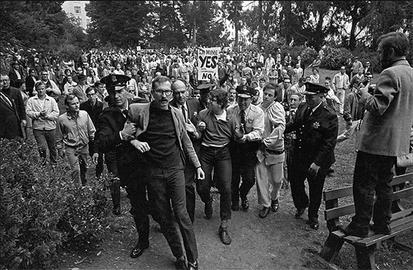
In recent years, various groups have used the tactic of guerrilla theater to wage political wars, including the group Reverend Billy and the Church of Stop Shopping, which fights against manic consumerism and irresponsible or predatory corporations. This group dresses its members as members of a religious order, suddenly enters a store, a shopping mall or the offices of a corporation and brings to the attention of the public the destructive role of a specific corporation or the general destructiveness of runaway consumerism.
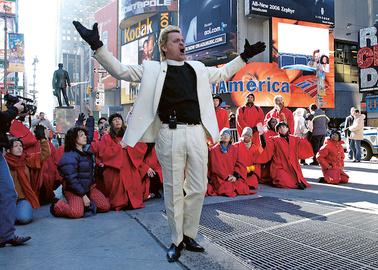
Another group of this kind is Billionaires for Bush, which was formed during the 2000 presidential election. Its members dressed like the wealthy and used guerrilla theater to satirically “support” George W. Bush, drawing attention to policies which were perceived to benefit corporations and the super-wealthy. The group organized a Million Billionaires March at the Republican National Convention in Philadelphia on the eve of the convention.
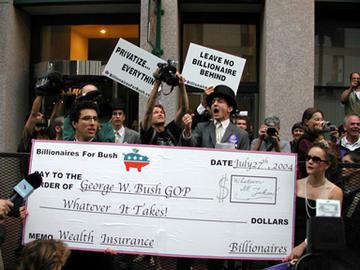
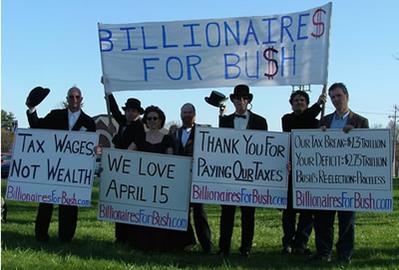
Another prominent guerrilla theater group is the “Clandestine Insurgent Rebel Clown Army,” whose members dress as clowns and use non-violent tactics to act against corporate globalization, war and other issues. The group originated around 2003 in the UK but has been active in various countries. It members usually participate in large rallies, and by teasing and ridiculing the police they try to remove fear among the protesters.
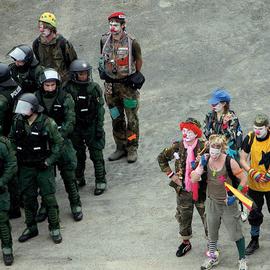
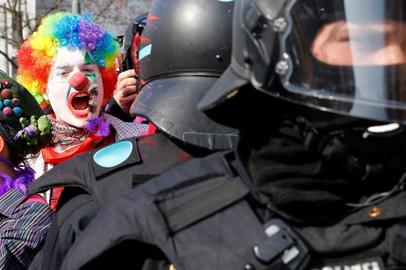
Tools, Goals and the Audience of Guerrilla Theater
The power of guerrilla theater lies in the flexibility of its tools and tactics, the small size of the troupe and its ability to move away from the scene before police officers arrive. Guerrilla theater can perform a complete play or just a scene of everyday life staged as “invisible theater,” meaning in a way that nobody can imagine what they are witnessing is actually a show. In other words, guerrilla theater does not ask for a permit from anybody, has no specific location, changes locations continuously, carries out its operations quickly and chooses its tools and tactics based on the performance’s goal and the situation in which it performs.
A guerilla theater performance follows three basic goals: (1) Showing that there is a problem, (2) showing the consequences of the problem and (3) pointing to a solution for the problem.
Each performance might follow only one of these goals and the choice of the goal must fit the location where the performance is to take place. American theater scholar Richard Schechner classifies locations for performing guerrilla theater into four groups: friendly, neutral, unfriendly and hostile.
Friendly locations are places where the majority of people who are present support your ideals. For instance, the performance of a guerrilla theater about the “Mahsa Uprising” in Ekbatan in western Tehran, one of the most important centers of recent protests, can be seen as a performance in a friendly environment. In such an environment you have no need to show the problem and its consequence because everybody present knows what the problem is and what the consequences are. Here, you just concentrate on presenting a solution for the problem. For example, a street theater about continuing the fight, the importance of resistance and keeping the uprising alive can be effective in such an environment. Another important point about friendly environments is that you are relatively safer and, if police arrive, there is a better chance that people would protect you.
In neutral environments, individuals don't necessarily support your ideas. You need to start your performance by presenting the problem. You must focus on enlightening the audience about the problem. At the same time, you are less safe and your performance must be shorter. For example, Tehran’s Vali-e Asr Square can be considered a neutral environment.
People in unfriendly environments generally do not agree with your ideas, see your presence as a provocation or at least feel uneasy about your performance. Examples of such an environment include the meeting of Iran Construction Engineering Organization, mentioned above, a film festival or an arts auction. In such an environment you need to stay cool, act quickly and expect the unexpected. You have not gone to such a location to offer a solution for the problem. You are there to challenge the dominance of an idea and show that this idea is no longer immune from courageous criticisms. So, your mere presence conveys your message and you must be prepared to leave the scene the moment when you feel threatened, while keeping your cool.
Hostile environments are those that are ready to prevent your presence and unleash violence against you. For example, performing in front of a Basiji base or the headquarters of the morality police is performing in a hostile environment. In such an environment, you have no need to present the problem. You are there to challenge their authority and show that you are not afraid of them. For them, you are the problem and they are ready to fight you. Therefore, you must either be ready for a fight or use the tactic of surprise. You must carry out your performance fast, record the performance to show it to others in order to boost their morale and immediately escape the arena. Or you must be ready for their violence, make their violence part of your theater and record it to show that, for example, they are responding to a peaceful action with savage violence. It is your choice and you must pay a price for either choice.
History of Guerrilla Theater in Iran
In Iran, political street theater has a clear and traceable history, but guerrilla theater, at least as we described it, needs further investigation. Oral sources say that it was part of street performances by the revolutionaries prior to the 1979 revolution but not many records of their specifics are available.
In 2011, the article Museum of the Streets by Abbie Hoffman, co-founder of the Youth International Party ("Yippies"), was translated and published by this author. The translation is, if not the first, one the first sources about the nature of guerrilla theater in Persian. Six years later, the website Meidaan published two important texts by R.G. Davis and Richard Schechner about guerilla theater, skillfully translated into Persian by Ali Gholipour. A year later, Gholipour and Anisa Raoufi published Street Is the Scene, a translation of a collection of articles about street theater that includes some articles about guerrilla theater.
In those years, Iranian universities were the most important centers of guerrilla theater or performances with some characteristics of guerrilla theater. Of course, a major part of students’ performances with political themes should be categorized as “forum theatrr” or the “theatre of the oppressed,” but, as we said, guerrilla theater is less about a specific style of performance and more about the situation and its manner of handling the performance and the audience. As a result, many of these performances can be categorized as guerrilla performances.
During a short trip to Iran in 2013, I held a workshop about guerrilla theater with the cautiously chosen name of Street Museum: Radical Theater. Some of the participants in this workshop later experimented with guerilla performances. In those years, many Iranian performance artists held unforgettable performances that can be counted as shining examples of guerrilla theater. One of the most important of them was a performance by Ali Mansouri and Rhizome Ensemble in Tehran’s shopping malls on March 8, 2014. In this performance, a man had tied the hand of a woman with a rope and dragged her behind him while he nonchalantly went from shop to shop.
A few years later, when I was not in Iran, I and a number of participants in the 2013 workshop formed the collective Liberation of the Everyday Life, organized by Afsaneh S. and Matin K. It carried out several performances in Isfahan and Tehran about the environment and air pollution. In one of these performances that took place with the cooperation of Parisa Jamali, Sahand C. and A.R., a man and a woman stood on the dried up bed of Zayandeh Rud river, holding a serum bottle filled with water that they injected into dry ground and invited the passers-by to hold the bottle for a few minutes.
Another performance that was organized by Afsaneh S. was Rebellion Without A Cause, which started with five people who had covered their faces with masks and were playing harmonica. Along the ways tens of passers-by joined them. Another performance, held on International Day for the Elimination of Violence Against Women, took place in several cafés in Isfahan and Shiraz by using the technique of “invisible theater,” reconstructing a made-up violent and humiliating quarrel in a public space. A man and a woman started quarreling and then the man started humiliating the woman, citing Iranian laws to prove his point. At this moment, a person would stand up to interfere. Then a second person would stand up to prevent the first person from interfering, arguing that quarrel was a private matter between a man and his wife. All of them were actors, but others who were present in the café interfered and passionate arguments over privacy and violence against women followed.
In November 2000, we held a number of remote workshops about guerrilla theater in Iran. A number of participants and organizers were among prominent figures in the students movement and workers’ and children's rights activists.
Recording and reviewing all such performances and identifying all active troupes is a formidable job, especially since this style of political struggle must remain anonymous in a country like Iran. Nevertheless, what we have witnessed in recent protests show that protest theater and especially guerrilla theater tactics can give a new life to civil struggle in Iran.
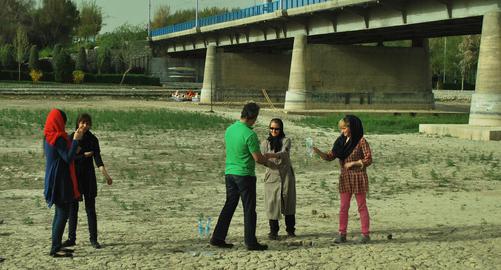
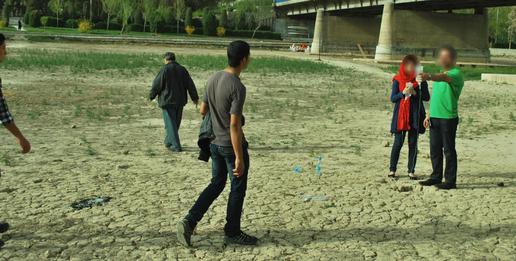
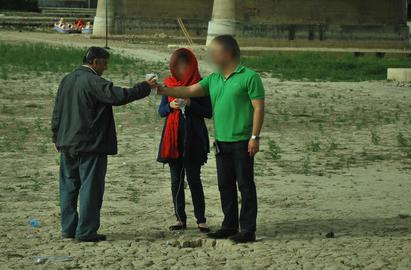
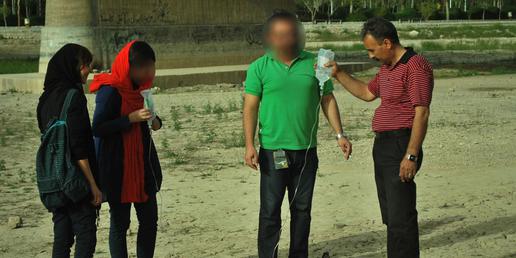
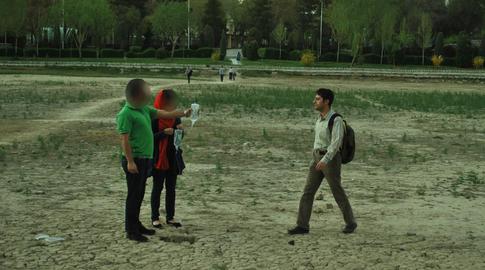
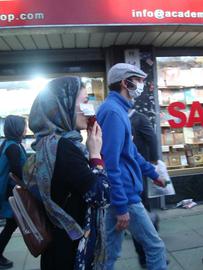
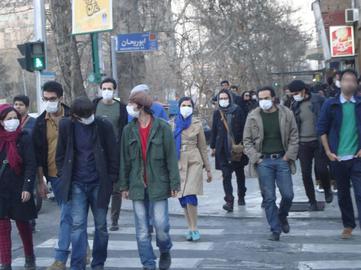
visit the accountability section
In this section of Iran Wire, you can contact the officials and launch your campaign for various problems





























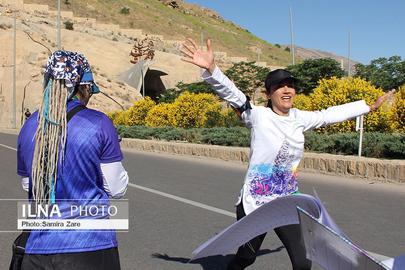
comments
The dystopian/utopian cult. The horror show of torture in real life. The Dutch, once again off in reverse creating in ways that are counterintuitive to intelligence while ironically but not, the nuclear underground bunker reveals itself in the news dating back as if it's over. Remember if they are in reverse, the y are still creating it. The anger, within the mind, that leads to one finger to press the nuclear button. These disgusting displays are nothing but entertainment, created and backed by dark mind manipulation tactics attempting to get attention to distract within the illusion while innocent people die and the world continues to burn so fakes can make monopoly money on pointless and lazy endeavors if you can even call it that. ... read more